Key takeaways:
- Understanding pH significantly affects flavor, texture, and safety in cooking, influencing everything from baking to food preservation.
- Adjusting pH through acidic ingredients enhances flavors, visual appeal, and can even engage our senses, transforming ordinary dishes into exceptional ones.
- Maintaining the right pH level is crucial for preventing spoilage and ensuring food safety during processes like fermentation and canning.
- Techniques such as using baking soda to balance acidity or timing the addition of acidic ingredients can greatly improve the outcome of a dish.
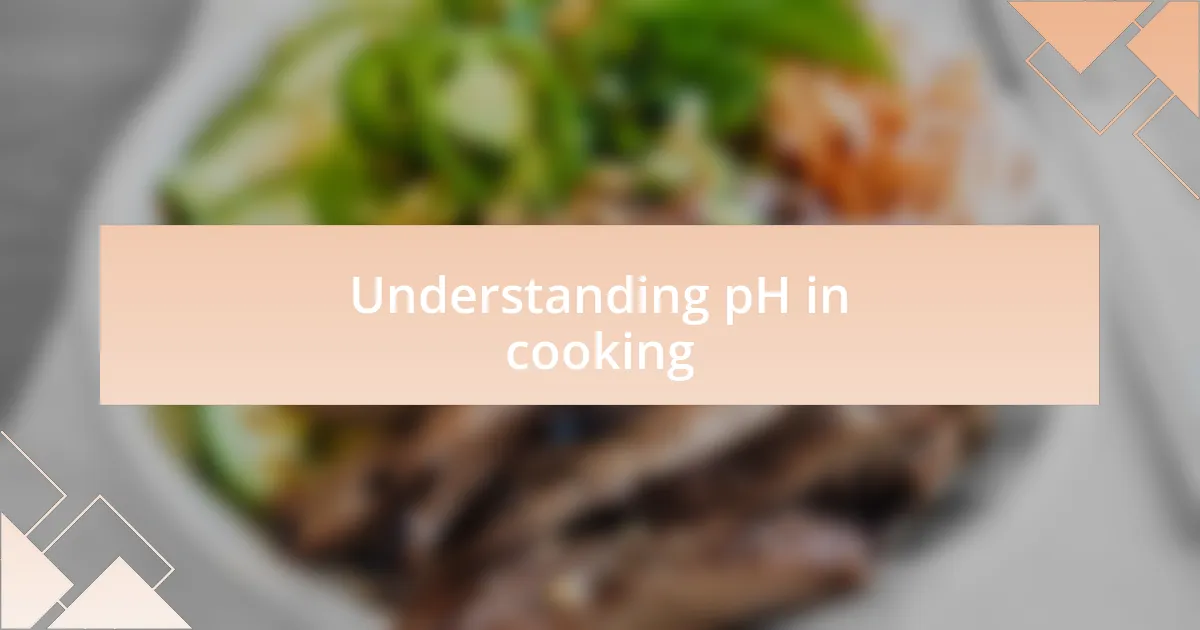
Understanding pH in cooking
Understanding pH in cooking is fundamental because it can dramatically influence the flavors and textures of our food. For instance, I remember the first time I adjusted the acidity in a tomato sauce. By simply adding a splash of vinegar, the flavors became brighter and more vibrant. Have you ever wondered how something as simple as pH can transform a dish so profoundly?
When I delve into baking, I find that pH plays a crucial role as well. The reaction between baking soda, which is alkaline, and acidic ingredients like yogurt or lemon juice not only affects rising but also influences the final taste. It’s fascinating to think that adjusting the balance of acids and bases can elevate a simple recipe into something remarkable.
Moreover, the concept of pH extends to food preservation. I often experiment with pickling, where the acid content is key to ensuring safety and flavor. It makes me reflect: how many culinary techniques rely on a robust understanding of pH? Mastering this aspect not only enhances my dishes but also gives me confidence in my cooking.
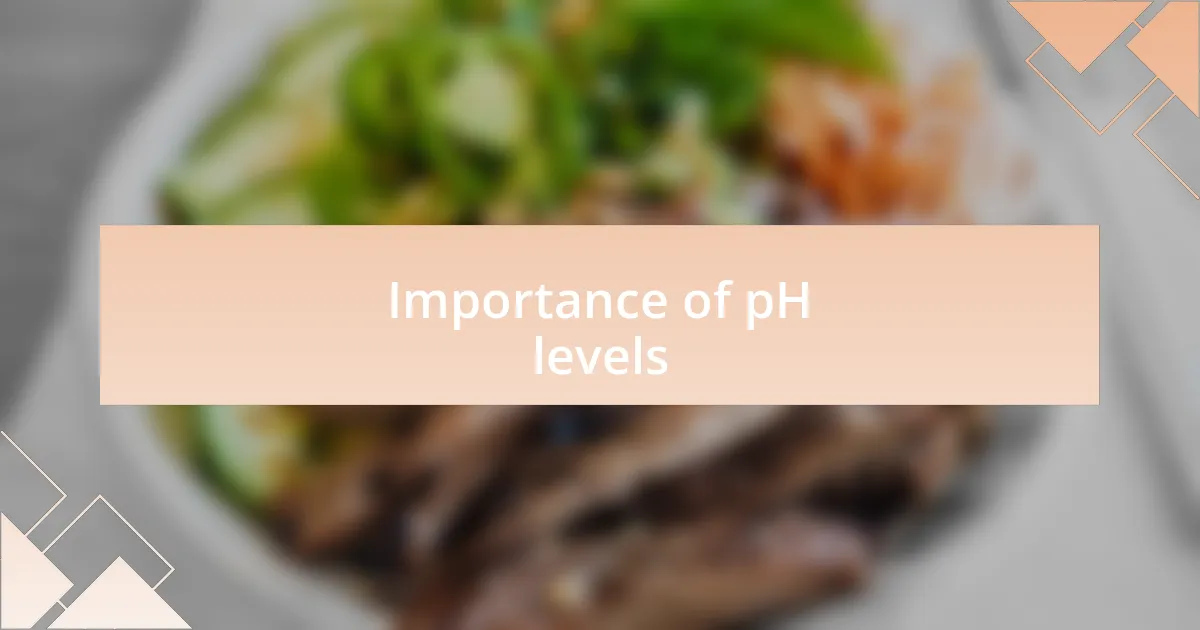
Importance of pH levels
The significance of pH levels in cooking goes beyond just taste; it’s a matter of chemistry that defines not only flavor but also safety. I recall an occasion when I was fermenting vegetables, marveling at how even the slightest change in acidity could yield a completely different end product. Have you ever considered how essential it is to maintain the right pH to avoid harmful bacteria during fermentation?
In my exploration of pH, I found that it plays a vital role in meat tenderization as well. For example, using an acidic marinade with ingredients like citrus or vinegar can break down tough proteins, resulting in a beautifully tender dish. It’s incredible how something so scientific can have profound culinary implications, isn’t it?
Furthermore, pH influences not just what we taste, but also the visual appeal of our food. When I experimented with blue corn tortillas, I was fascinated to observe how they changed from blue to a vibrant shade of pink when interacting with lime juice – a phenomenon that stems from the pH level. This visualization of pH in cooking proves just how interconnected flavor, texture, and color really are.
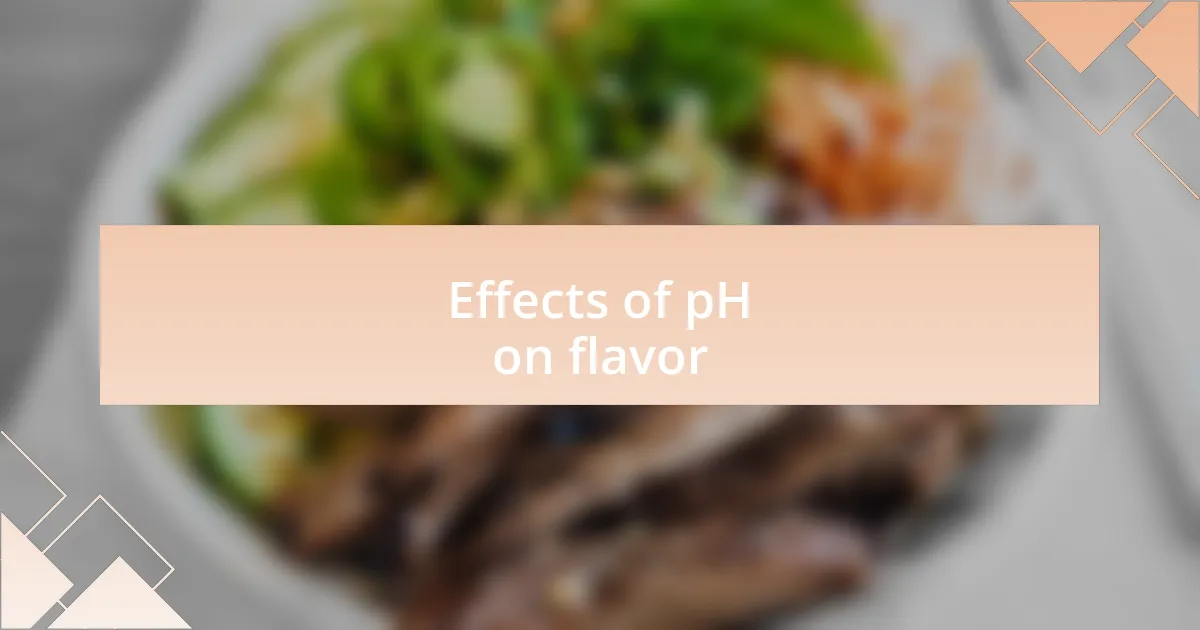
Effects of pH on flavor
The interplay between pH and flavor is truly remarkable. I remember a cooking session where I experimented with pickling fruits. The addition of vinegar not only introduced a sharp tang but also brought out the sweetness of the fruits, showcasing how acidity can enhance and balance flavor profiles. Isn’t it fascinating how a simple pH adjustment can transform a dish from bland to extraordinary?
In my culinary adventures, I’ve noticed that the pH of ingredients can shift the overall taste experience. For instance, I once made a batch of homemade salsa with tomatoes, onions, and lime juice. The brightness from the lime’s acidity made the salsa pop, turning what could have been a flat flavor into a vibrant explosion on the palate. Have you ever thought about how much more enjoyable a dish can become through careful manipulation of its acidity?
Interestingly, I’ve also found that pH influences the aromatic compounds in food. When I seared a pork tenderloin with a citrus glaze, the acidic environment not only elevated the meat’s flavor but released enticing aromas that wafted through my kitchen. This opened my eyes to the idea that pH does more than just affect taste—it can also engage our senses in unexpected ways.
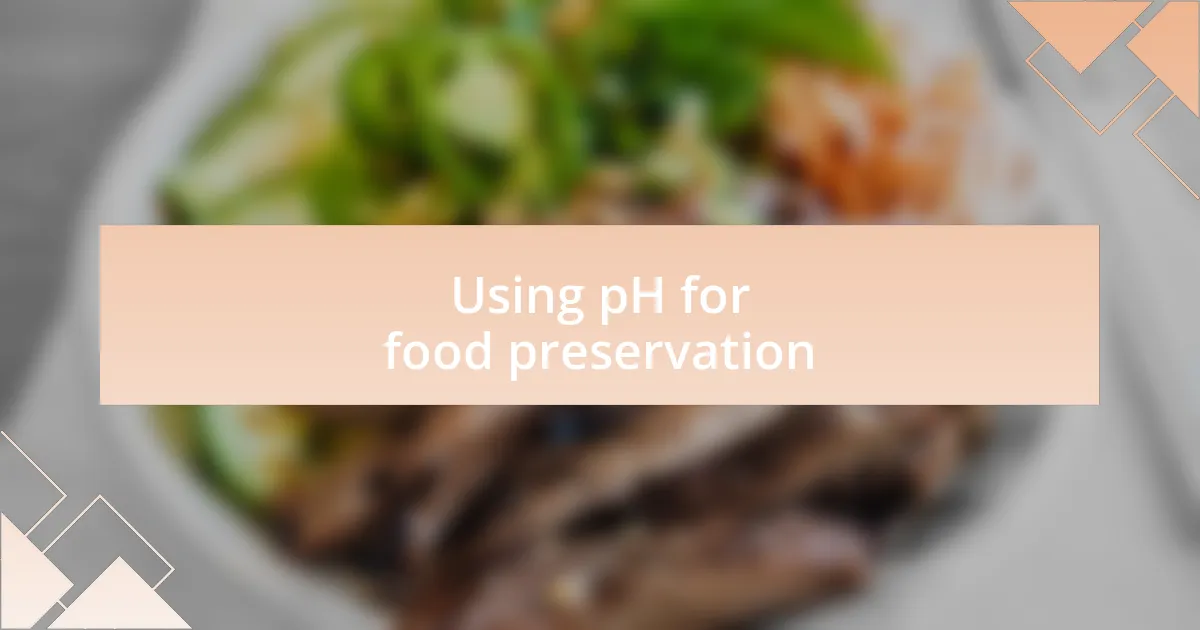
Using pH for food preservation
Using pH for preservation has been a game-changer in my kitchen. I recall the time I decided to make my own pickled vegetables. By adjusting the acidity with vinegar, I was able to create a tangy brine that not only extended the shelf life of the veggies but also added a vibrant crunch to my meals. Isn’t it amazing how something as simple as adjusting pH can transform fresh produce into a durable and delicious staple?
During one summer, I also experimented with preserving fruits using the art of canning. I carefully monitored the pH levels, ensuring they stayed within an acidic range. This not only prevented harmful bacteria from developing but also resulted in beautifully preserved jars of strawberries that retained their color and flavor. Have you ever noticed how the right acidity can make a jar of jam taste fresh long after its harvest?
Moreover, I’ve discovered that incorporating lower pH ingredients can create a safer environment for food storage. When I prepared a batch of fermented hot sauce, the natural acidity from the fermentation process not only intensified the flavors but also inhibited spoilage. It’s incredible to think that by understanding the science of pH, I can create dishes that not only tantalize the taste buds but also keep us safe and nourished for longer.
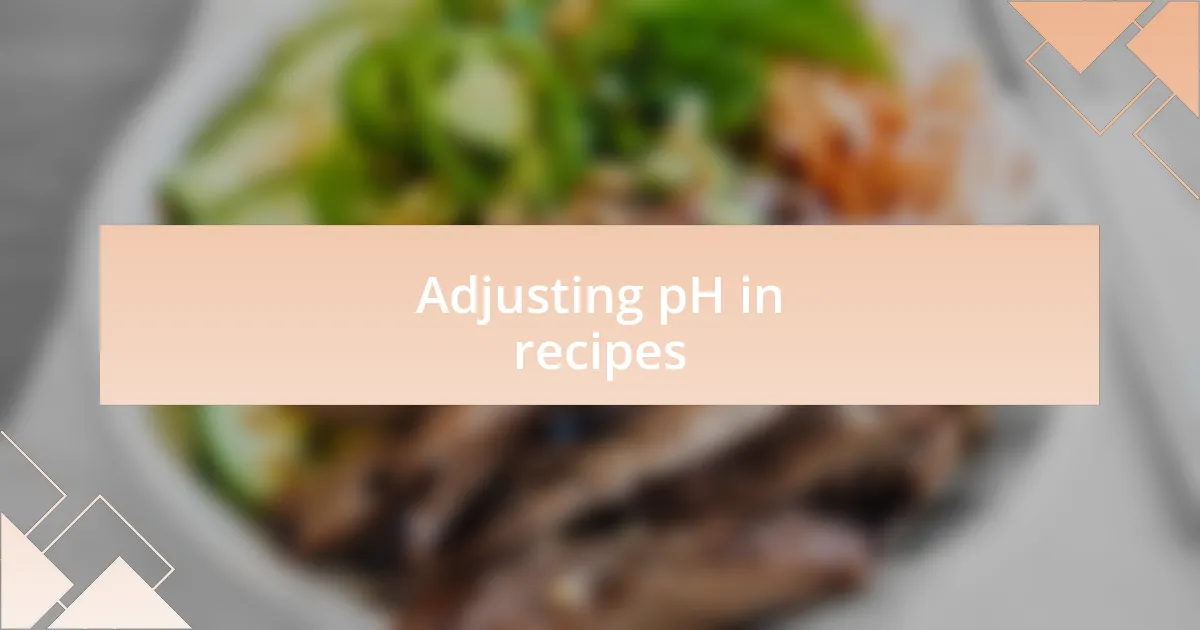
Adjusting pH in recipes
Adjusting pH in recipes can lead to surprisingly delightful results. For instance, when I experiment with sauces, I often start with a base of tomatoes. By adding a splash of lemon juice, I’ve noticed how it brightens the overall flavor. Have you ever tried a sauce that felt flat until just a touch of acidity transformed it into something vibrant and exciting?
I recall a particular instance while baking where I decided to tweak the pH of my dough by incorporating buttermilk instead of regular milk. This choice made all the difference in texture and taste. The slight acidity helped the baking soda to activate, resulting in a wonderfully tender and fluffy cake. It’s amazing how this small adjustment can elevate a recipe in such a significant way.
Sometimes, I find that the pH of a dish impacts how flavors meld together. For example, if a dish seems too salty, I often reach for a splash of vinegar. That simple action can balance out the flavors, creating a harmony I wouldn’t have achieved otherwise. Do you ever use acidity as a flavor enhancer in your cooking? It’s a technique that has never failed to surprise me, proving that understanding pH can truly transform our culinary creations.
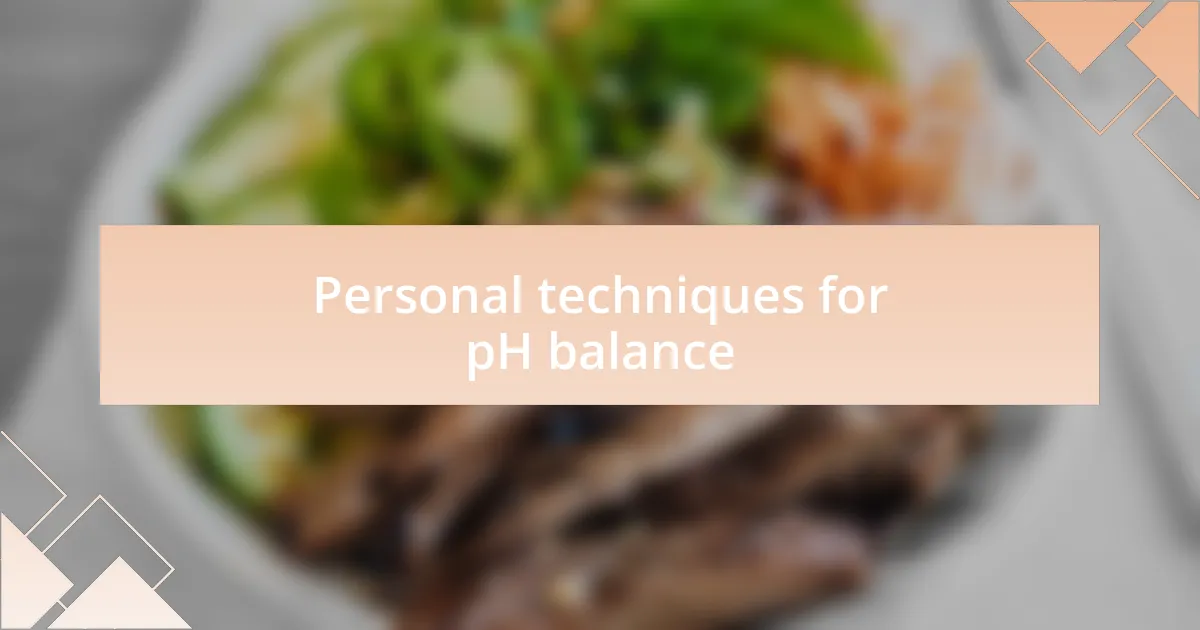
Personal techniques for pH balance
When I’m experimenting with pH balance, one technique that stands out is the use of baking soda in certain dishes. For instance, I once made a batch of caramelized onions that turned out a bit too acidic for my liking. By sprinkling in just a pinch of baking soda, I noticed how the bitterness smoothed out the sharpness of the acidity. Have you ever tried this trick? It’s like magic, transforming a dish into something pleasantly sweet and complex.
Another method I often use involves fresh herbs. When I make a salad, I love to drizzle a bit of apple cider vinegar on top. Not only does it brighten the overall profile, but it also enhances the fresh flavors of the herbs. It’s fascinating how a simple acid can amplify the essence of the ingredients. I often wonder—what is it about acidity that unlocks these vibrant tastes?
I’ve also found that the time of adding acidic ingredients can significantly influence the outcome of a dish. While making a creamy risotto, I’ll stir in some white wine later in the cooking process, allowing its acidity to elevate the creaminess without overwhelming the dish. This practice has led me to reflect on how timing can be just as important as the ingredients themselves. Have you played around with when you add acidity in your cooking? The difference can be astonishing.